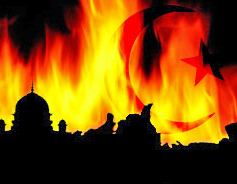
Furthest Mosque:-
17: 1 Glory to (Allah) Who did take His Servant for Journey by night from the Sacred Mosque to the Farthest Mosque [al Masjid al Aqsa] whose precincts We did Bless in order that We might show him some of Our Signs: for He is the one Who heareth and seeth (all things).
# The Farthest Mosque must refer to the site of the Temple of Solomon in Jerusalem on the hill of Moriah, at or near which stands the Dome of the Rock, called also the Mosque of Hadhrat 'Umar. This and the Mosque known as the Farthest Mosque (Masjid-ul-Aqsa) were completed by the Amir 'Abd-ul-Malik in A.H. 68. Farthest, because it was the place of worship farthest west which was known to the Arabs in the time of the holy Prophet: it was a sacred place to both Jews and Christians, but the Christians then had the upper hand, as it was included in the Byzantine (Roman) Empire, which maintained a Patriarch at Jerusalem. The chief dates in connection with the Temple are: it was finished by Solomon about B.C. 1004; destroyed by the Babylonians under Nebuchadnezzar about 586 B.C.; rebuilt under Ezra and Nehemiah about 515 B.C.; turned into a heathen idol-temple by one of Alexander's successors, Antiochus Epiphanes, 167 B.C.; restored by Herod, B.C. 17 to A.D. 29; and completely razed to the ground by the Emperor Titus in A.D. 70. These ups and downs are among the greater Signs in religious history#
*** I would like the reader to be aware that NOT ONCE in the whole of the Quran is there any mention of the name JERUSALEM.
On the other hand, the name of JERUSALEM is repeated almost 667 times in the Bible.
Hence, it is only in the fertile imagination of the later followers of Muhammad that an association and a linkage was CONCOCTED between Al Masjid al Aqsa and the
Temple of Solomon in Jerusalem especially since in the days of Muhammad,
THERE WAS NO TEMPLE OF SOLOMON in Jerusalem.
30: 1 Alif Lam Mim. 2 The Roman Empire has been defeated
30: 3 In a land close by [Adna'l Ardth] ; but they (even) after (this) defeat of theirs will soon be victorious
#3505 The remarkable defeats of the Roman Empire under Heraclius and the straits to which it was reduced are reviewed in Appendix No. 6 (to follow this Sura). It was not merely isolated defeats; the Roman Empire lost most of its Asiatic territory and was hemmed in on all sides at its capital, Constantinople. The defeat, must refer to Syria and Palestine, Jerusalem was lost in 614-15 A.D., shortly before this Sura was revealed#
*** Since the events that are mentioned in the verses above, based on the known historical record actually concern Jerusalem, then the expression "In a land close by" , "Adana'l Ardh.." cannot also be the land of the "Masjid al Aqsa
"
".. the Furthest mosque
" mentioned in Surat al Isra.
Even the interpreter asserts that "in a land close by" must refer to
Syria and Palestine. He considers Syria among the "land close by" even though it is further from the Ka'ba than Jerusalem in Palestine.
It is a physical impossibility to have a certain geographical location being both NEAR as well as VERY FAR from another given geographical location excluding the possibility of having to go around the circumference of the Earth to achieve it.
Since BOTH verses are found in the Quran and only 30:3 can be ascertained on historical and linguistic grounds that the subject concerned is the earthly Jerusalem, then the Furthest Mosque could not have been in Palestine's Jerusalem but most probably the one in Heaven as alluded to in Rabbinic traditions of which Muhammad had a goodly knowledge ***